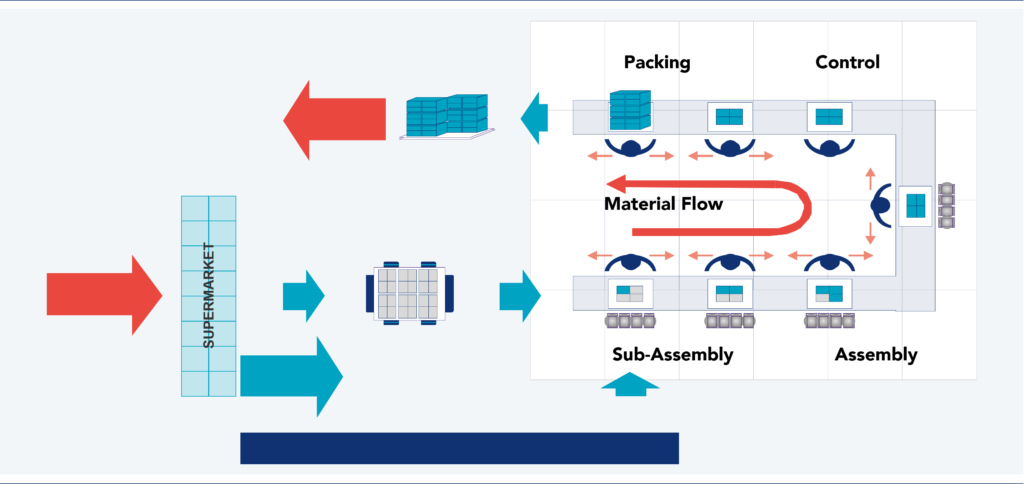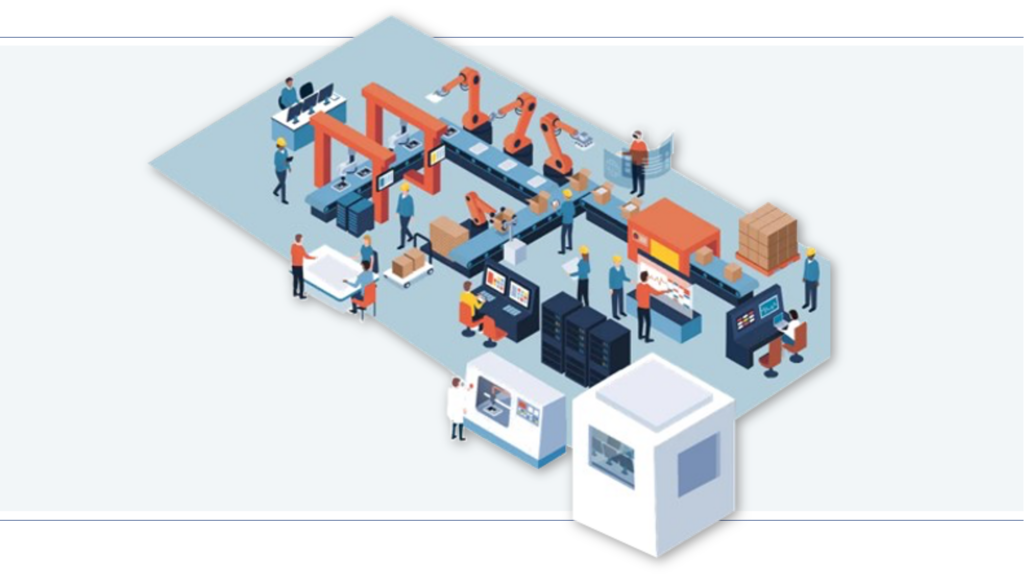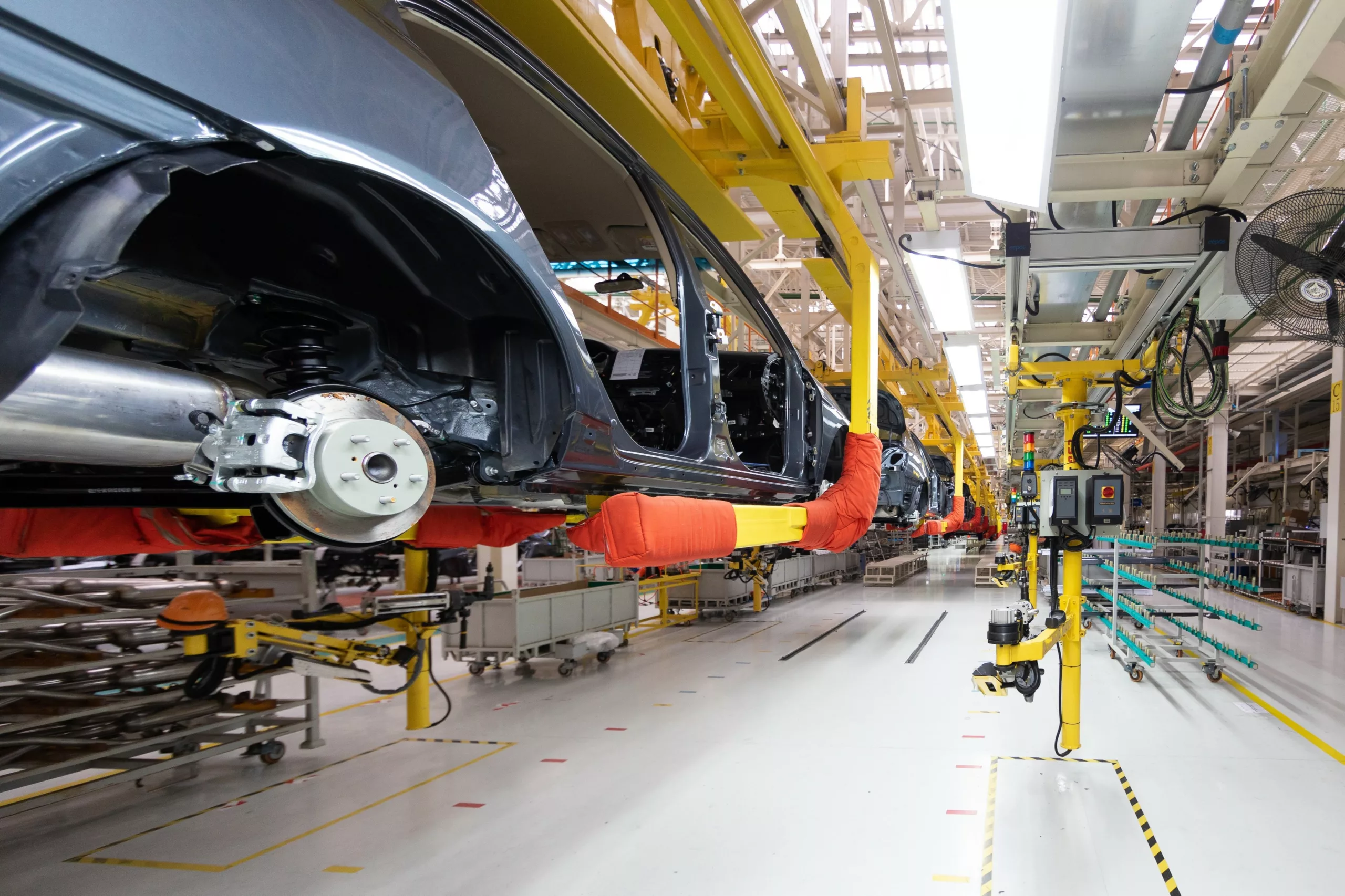In the current business landscape, discrete manufacturing industries are immersed in a highly competitive and demanding environment. This new scenario requires organizations to urgently improve their value chain management and adopt new practices for digital transformation.
We will explore how implementing Kaizen Lean, combined with technological advancements, can be the key to achieving operational excellence in discrete manufacturing industries.
It is crucial to remember that Kaizen and Lean methodologies are deeply rooted in this type of industry, having their origins in the automotive industry – specifically Toyota in Japan. Over the years, numerous success stories have been documented, highlighting the tangible benefits of Kaizen Lean. Introducing new technologies, such as Artificial Intelligence and advanced Data Analysis, complements and enhances the advantages of these continuous improvement methodologies in organizations.
Discrete manufacturing: definition
Discrete manufacturing refers to the process in which a specified quantity of material moves as a unit between workstations, such as cars, computers, and furniture, to quote a few. Unlike continuous production, where production is uninterrupted and products are generally uncountable, such as in the chemical industry, each product is an individual entity in discrete manufacturing.

Examples of discrete manufacturing in various industries
Discrete manufacturing is a method used in multiple industries. Below are some examples of discrete manufacturing industries.
- Automotive industry: discrete manufacturing in the automotive industry is a classic example. We can witness this type of production in manufacturing vehicles and their components, such as engines, suspensions, and seats.
- Aerospace industry: discrete manufacturing is predominant in aircraft and their components. Each plane and each of its components are produced one by one.
- Electronics industry: producing electronic devices, such as smartphones, laptops, or gaming consoles, is another example of discrete manufacturing. Each product is assembled individually.
- Medical equipment industry: In producing medical equipment, such as imaging devices, prostheses, and surgical instruments, discrete manufacturing is also predominant.
These examples highlight how important discrete manufacturing is in various areas, showcasing it as an essential approach to producing multiple types of products.
Discrete manufacturing basic principles
Discrete manufacturing requires a strategic and efficient approach to ensure operational success. Below, we dig into five fundamental principles of maximizing efficiency and minimizing waste in this industry.
Define value for the customer: the first essential step to success is understanding and defining value from the customer’s perspective. By aligning production processes with customer expectations, companies can reduce waste, optimize resources, and deliver products that meet market needs.
Visualize the value chain and identify waste: visualizing the value chain is essential for identifying improvement opportunities and eliminating waste. Organizations can identify inefficiencies, bottlenecks, and non-value-added activities by mapping each step, from acquiring raw materials to delivering the final product.
Create flow and eliminate Muda (waste): creating flow – increasing the speed of materials and information throughout the value chain – is essential for improving efficiency in discrete manufacturing. Eliminating Muda is crucial for achieving this goal. This includes reducing lead times, waiting times, and unnecessary movements.
Implement a pull system and just-in-time: instead of producing based on forecasts, a pull system responds directly to customer demand. This means that products are only made when there is actual demand, avoiding excess inventory and ensuring production is aligned with market needs.
Pursue the “True North”: organizations should aspire to operational excellence. This implies a continuous search for improvement, gradually and continually eliminating all forms of waste.
These five foundations form the backbone of an effective strategy aimed at optimizing processes, eliminating waste, and providing value to the customer.
Critical elements for successful discrete manufacturing
In line with the fundamental principles mentioned above, achieving success in discrete manufacturing requires a strategic and integrated approach involving various vital elements linking together to optimize processes and achieve operational efficiency. In this context, we highlight six key elements that, when efficiently managed, lead to exceptional results.
Supply chain management: maximizing efficiency
As is the case for discrete manufacturing, efficient supply chain management is critical for operational success in various industries.
Before implementing improvements, it is essential to have a comprehensive understanding of the value chain. This involves mapping all the links involved in the chain, from suppliers to final customers. This holistic view lays the foundation for implementing improvements.
Effective integration of information systems is essential in this process. By adopting technologies such as ERP systems, coordination between different chain stages can be more efficient. This results in greater visibility and communication, which is essential for informed decision-making.
Inventory management is another fundamental element of supply chain management and optimization. A suitable planning method enables inventory reduction, which minimizes storage costs and optimizes resource efficiency. Delivering materials precisely when needed elevates operational efficiency and makes problems visible.
Equipment efficiency improvement
Improving equipment efficiency is a key element in discrete manufacturing, directly impacting the ability to respond effectively to demand, reduce operational costs, and ensure quality.
A crucial starting point is implementing effective autonomous and planned maintenance strategies. This will increase equipment availability and reliability.
Optimizing setup time is another essential activity. Minimizing changeover times and reducing/eliminating equipment setup and preparation accelerates the transition between different batches, increases operational flexibility, and reduces unproductive intervals.
Investing in advanced technologies, such as automation, smart sensors, and IoT, offers a significant leap in equipment efficiency. Automated systems facilitate continuous production, while real-time data collection provides valuable insights for accurate performance analysis and improved reaction speed.
Improving flow on the assembly line
Efficiency on the assembly line is vital for success in discrete manufacturing, where accurately synchronizing activities plays a crucial role.
It is recommended to start with the design and layout of the assembly line, ensuring that workstations are organized to minimize waste and bring flexibility. A well-planned and ergonomic layout optimizes the production workflow.

Standard work is also a key element in improving flow on the assembly line. Establishing standards for each step of the process and training operators reduces variability, minimizes errors, and facilitates cycle time predictability, resulting in a more consistent flow.
Implementing an efficient supply system to the assembly line is crucial. For this purpose, logistic trains (Mizusumashi), which have standardized work and are synchronized with the line’s supply needs at each station, are often used. This system ensures the assembly line is constantly fed at the points of use, minimizing interruptions and maintaining continuous flow.
Pull production
The transition from push production to pull is a fundamental strategy for discrete manufacturing companies.
In push production, manufacturing is driven by demand forecasts, resulting in high inventories and a greater tendency for waste. On the other hand, the pull system is based on production according to actual demand, minimizing inventories and improving efficiency and service levels.
The pull system typically uses the Kanban system. Kanban, which means “card or signal” in Japanese, is a visual tool that helps control the production flow, signaling the need to produce or replenish items as demand arises.
Another essential element for pull production is the use of supermarkets. A supermarket is an easily accessible storage area for picking (at ground level), with visual management and replenishment driven by consumption.
Quality control
Quality management plays a central role in discrete manufacturing, being a definite factor for customer satisfaction, market competitiveness, and operational efficiency.
Each stage of the manufacturing process can guarantee its quality, avoiding the need for final inspections and late detection of problems. The goal is that at each step of the process, it does not receive, produce, or pass on defects, ensuring quality at each station. This is achieved through self-quality techniques, such as work standards, quality standards, or poka-yoke (mistake-proofing) systems preventing defects or assisting in detecting them.
Real-time process control is another effective way to ensure quality, as it identifies process deviations immediately. This reduces the response time to quality issues and empowers the team to take corrective action before there is an impact on the final product.
Various tools and methodologies can be used in quality improvement. Their selection should be made according to the needs of each production line.
The power of data
The discrete manufacturing landscape is rapidly evolving, driven by digitalization and the growing availability of data. The ability to collect information throughout the entire value chain creates unprecedented opportunities for optimization, efficiency, and innovation.
Integrating Artificial Intelligence systems and Advanced Analytics is a focal point in this revolution. These systems can analyze large volumes of structured and unstructured data and extract patterns, trends, and correlations inaccessible through conventional methods.
The main goal is to obtain deep insights driving informed decision-making. With the ability to process large volumes of data in real-time, AI systems and advanced data analytics provide a comprehensive understanding of production processes, identifying improvement areas and optimization opportunities.
Fostering continuous improvement with technology in discrete manufacturing
The connection between technology and continuous improvement in discrete manufacturing is crucial for analysis and innovation in the current industrial environment. Strategically using technology as an effective tool for advancing continuous improvement redefines operational efficiency and the adaptation of organizations when facing constantly evolving challenges.
Embracing technological advancements
Integrating and adopting technological advancements are necessary to drive discrete manufacturing efficiency, flexibility, and quality. By embracing innovations, companies can remain competitive and lead the way towards smarter and more agile production. Below, we explore some of the technological advancements transforming discrete manufacturing.
- Dynamic scheduling tools adapting to changes in production needs and resource availability (workers, robots, tools, etc.) in real-time;
- Mobile collaborative robots on the production line with advanced vision systems and grippers that perform specialized tasks;
- Continuous human-machine interaction in the production flow with load balancing supported by AI;
- Digitally enabled self-quality means to prevent and detect defects early;
- Equipment connected to intelligent sensor networks and with advanced self-diagnostic capabilities to autonomously identify and report maintenance needs or changes in input parameters, contributing to predictive maintenance strategies.
- Innovative closed-loop systems showing real-time adaptability, driven by continuous data analysis and optimization objectives. These mechanisms ensure that machines automatically adjust to maintain ideal performance and efficiency.
- Integration between the Computerized Maintenance Management System (CMMS), Manufacturing Operations Management System and Digital Twins to capture working conditions and equipment context to feed advanced Machine Learning algorithms to predict the likelihood of failure better and prescribe preventive actions.
- Incorporation of AIDC (Automatic Identification and Data Capture) technologies, such as RFID and QR codes, for tracking tools accurately and accessing digital formats of machine information, including historical data and manuals, simplifying operational efficiency.

These are just a few examples of innovations and technologies revolutionizing discrete manufacturing and enhancing operational excellence. By embracing these technological advancements, companies can optimize their processes and position themselves at the forefront of innovation, prepared to face future challenges with resilience and excellence.
Kaizen in discrete manufacturing
The Kaizen Institute supports companies in defining and implementing a continuous improvement strategy. The Kaizen Institute ensures the fundamental practices of Lean Manufacturing are aligned with new technologies to optimize discrete manufacturing.
The Kaizen Institute adopts a holistic approach, recognizing operational excellence beyond applying isolated tools. Kaizen works on developing an organizational culture geared towards continuous improvement, empowering employees to embrace Kaizen as a mindset. This creates a solid foundation to sustain improvements over time.
Partnership with the Kaizen Institute generates measurable efficiency, quality, cost reduction, and customer satisfaction improvements. Various success stories prove how implementing Kaizen in discrete manufacturing solves immediate operational challenges and prepares organizations to thrive in an ever-evolving business environment.
The Kaizen Institute is the ideal partner for organizations looking to deploy digital transformation, leading them to operational excellence.
Still have questions about discrete manufacturing?
What defines a product as ‘discrete’ in manufacturing?
In discrete manufacturing, products are distinct and separate, easily identifiable as individual units, both during production and as finished products.
What products are typically made through discrete manufacturing?
Some examples of items produced through discrete manufacturing include electronic products (mobile phones, computers, game consoles, cameras, etc.), appliances, cars, toys, footwear, and medical equipment, among many others.
What are the elements of discrete production?
Discrete manufacturing is centered on transforming raw materials into finished goods, and although processes may vary among different industries, most share some essential elements:
- Supply chain: the supply chain is the network of organizations, activities, resources, information, and technologies involved in producing and distributing a product or service. Effective supply chain management is crucial in discrete manufacturing.
- External logistics: external logistics refers to activities outside the company’s facilities involving transporting and storing raw materials and components and distributing finished products to customers.
- Internal logistics: internal logistics involves logistic activities performed within the company’s facilities, from the raw materials and components warehouse to the finished product warehouse, and covers stock management, moving materials between different areas, and efficient storage, to name a few.
- Bill of materials and process diagram: the bill of materials lists the components constituting a product. The process diagram is a graphical representation that describes the steps in a process, illustrating stages from incoming raw materials to finished product output.
- Assembly line: in discrete manufacturing, the assembly line is crucial as it involves assembly and production at various stations located along an assembly line, also known as a production line.
- Planning model: the production planning model is a set of rules used to organize and coordinate production activities in a factory. It aims to meet market demand, optimize resource use, minimize costs, and ensure operational efficiency.
See more on Discrete Manufacturing
Find out more about transformation in this sector
See more on Operations
Find out more about improving this business area
